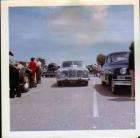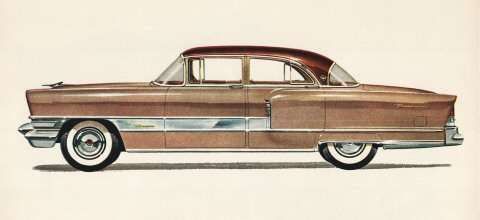|
Re: Trans Fluid for a twin ultramatic? Power Steering fill mark and fluid?
|
||||
|---|---|---|---|---|
|
Home away from home

|
ok. But it begs the question:
What harm will the DEX-Merc do to the T'Ultra???? Shorten it's service life??? Make it run hotter????? firmer shift as opposed to softer shift OR what??? I really don;t know. My personal preference in any case is longevity between rebuilds. I can live with ANY way that it shifts if service life is optimal.
Posted on: 2011/9/24 10:55
|
|||
|
VAPOR LOCK demystified: See paragraph SEVEN of PMCC documentaion as listed in post #11 of the following thread:f
packardinfo.com/xoops/html/modules/newbb/viewtopic.php?topic_id=7245 |
||||
|
||||
|
Re: Trans Fluid for a twin ultramatic? Power Steering fill mark and fluid?
|
||||
|---|---|---|---|---|
|
Home away from home

|
Seems logical but i suppose a test would have to be conducted. Or maybe the smoother softer shift is allot easier on engine bearings. Again, something that only a controlled rigorous Proving grounds test would confirm or negagte.
So i suppose it really doesn;t matter type F or Dex-Merc until enuf miles have been beaten into a transmission to tell for sure.
Posted on: 2011/9/24 12:49
|
|||
|
VAPOR LOCK demystified: See paragraph SEVEN of PMCC documentaion as listed in post #11 of the following thread:f
packardinfo.com/xoops/html/modules/newbb/viewtopic.php?topic_id=7245 |
||||
|
||||
|
Re: Trans Fluid for a twin ultramatic? Power Steering fill mark and fluid?
|
||||
|---|---|---|---|---|
|
Home away from home
|
Not knowing much about the properties of automatic transmission fluids I will ask some dumb questions.
Keeping in mind I drive a Model T-Ford a lot and it uses bands and a disc clutch and runs in dirty SAE 30 motor oil just fine. I drive a 54th series (1954 Cavalier) with the non-gear start Ultramatic transmission. In "H" range the only thing shifting is the direct clutch. As I understand the original fluid was a hydraulic fluid and it contained some Whale oil which gave a little slip (friction modifier). I believe Whale oil is now unobtainium. Is this what they called type "A"? When I bought my car the former owner told me the transmission took Dexron III. When I was at the local auto store they don't stock anything called Dexron III but they told me the DEX-Merc was the same stuff, so I got a couple of quarts but have not dumped it in the transmission yet. So more questions. Any transmission fluid will probably work just fine in a pinch? The friction modifiers add slip to the engagement of bands and clutches which would make the clutch engage more smoothly. My car in "H" drive mode is only engaging the torque converter direct clutch which doesn't slip but engages fairly quick but not too harsh in my opinion. Low, or Reverse engages bands and they engage quite quick with no slip but again it doesn't seem harsh. The gear-start Ultramatic is going to do a synchronized clutch engagement to get from low to high range so it needs a little slip hence friction modifiers. And the final judgment is to either use Dex-Merc or something with those words, or find Dexron III. Don't use type F. This is more confusing than buying toothpaste :) I think the factory should issue a bulletin.
Posted on: 2013/2/20 15:28
|
|||
|
||||
|
Re: Trans Fluid for a twin ultramatic? Power Steering fill mark and fluid?
|
||||
|---|---|---|---|---|
|
Forum Ambassador

|
Jim -
Have you read BOTH of the following FAQs?: ULTRAMATIC: Ultramatic Transmission - A Primer ULTRAMATIC: What Fluid to Use Quote: I drive a 54th series (1954 Cavalier) with the non-gear start Ultramatic transmission. In "H" range the only thing shifting is the direct clutch. The only automatic shift you should experience in the original, non-GearStart, Ultramatic is into and out of Direct Drive - in both Low and High range. Quote: As I understand the original fluid was a hydraulic fluid and it contained some Whale oil which gave a little slip (friction modifier). I believe Whale oil is now unobtainium. Is this what they called type "A"?... In the beginning, there was only Type A. Friction modifiers came later, resulting in AQ-ATF (aka - Type A, Suffix A), and then Dexron (aka - Type B). Whale oil was later eliminated, replaced with alternate friction modifiers, which resulted in Dexron II. Dexron III was later formulated specifically for the needs of electronic transmissions. Meanwhile, Ford had broken away with their own formulation, Type F, to meet their particular choice of friction materials, but eventually changed to Mercon, which is so similar to Dexron III that they're considered to be interchangeable. Discussing synthetic ATF is so confusing that it makes my head hurt; purchasing synthetic ATF makes my wallet hurt. Personally, I would only use synthetic fluid where specified and required by the vehicle manufacturer. I can't think of any real advantage to use a synthetic in the Ultramatic. Quote: When I was at the local auto store they don't stock anything called Dexron III but they told me the DEX-Merc was the same stuff, so I got a couple of quarts but have not dumped it in the transmission yet. Read the label on the back of the bottle; it should advise of compatibility WRT Dexron III. Dexron, Type F and B&M Trickshift fluids seem to be compatible with the Ultramatic, but what works best depends on your particular situation. If you're not having any problems try Dexron. If not satisfied, do a COMPLETE drain and refill with Type F. Still not satisfied, try Trickshift. Beyond that, it's probably time for repair or rebuild.
Posted on: 2013/2/20 22:44
|
|||
|
||||
|
Re: Trans Fluid for a twin ultramatic? Power Steering fill mark and fluid?
|
||||
|---|---|---|---|---|
|
Forum Ambassador

|
In post #30 of this thread, I erred when wrote that:
Quote: Dexron III can be used in place of Mercon V and earlier formulations thereof. ...but cannot edit a post that old. Mercon V (5) is a synthetic fluid; Dexron III is NOT. Therefore, you should NEVER use Dexron III where Mercon V is specified by the vehicle manufaturer. Dexron III is only compatible with earlier formulations of Mercon.
Posted on: 2013/2/20 23:25
|
|||
|
||||
|
Re: Trans Fluid for a twin ultramatic? Power Steering fill mark and fluid?
|
||||
|---|---|---|---|---|
|
Just can't stay away
|
G'day all,
From the info above..."Dexron, Type F and B&M Trickshift fluids seem to be compatible with the Ultramatic, but what works best depends on your particular situation. If you're not having any problems try Dexron. If not satisfied, do a COMPLETE drain and refill with Type F. Still not satisfied, try Trickshift. Beyond that, it's probably time for repair or rebuild." I just finished a rebuild, it seems from the summary above that any of the mentioned do just fine. With caution - stay away from Type A Is this still the feeling? Cheers Russ
Posted on: 2014/3/5 4:52
|
|||
|
Russ (the prodigal son)
56 400 (sold 2022) 39 1702 7 pass touring (long term project) 38 1602 7 pass limousine (needs work) Learnt to drive on a 50 in 1969 |
||||
|
||||
|
Re: Trans Fluid for a twin ultramatic? Power Steering fill mark and fluid?
|
||||
|---|---|---|---|---|
|
Forum Ambassador

|
No reason that I'm aware of to stay away from Type A, it's just that it's pretty much no longer available. Type FA is also an alternative though I use Type F and have for some time with no problems. All of my friends with Twin Ultramatics use Type F with one exception who is using TrickShift to mitigate a groaning clutch issue (with some modest success).
PS- answering your other questions - I use the same trans fluid in the power steering. My PS cap still has the hanging dipstick but the dipstick had a propensity for falling off into the pump and many have been removed so just fill (wafrm) to about a inch above the top of the filter cartridge.
Posted on: 2014/3/5 8:45
|
|||
|
||||
|
Re: Trans Fluid for a twin ultramatic? Power Steering fill mark and fluid?
|
||||
|---|---|---|---|---|
|
Webmaster
|
I'm running type F with two quarts of Lucas Transmission Snakeoil. So far the Ultra is staying together and keeping the car moving.
Posted on: 2014/3/5 14:05
|
|||
|
-BigKev
1954 Packard Clipper Deluxe Touring Sedan -> Registry | Project Blog 1937 Packard 115-C Convertible Coupe -> Registry | Project Blog |
||||
|
||||
|
Re: Trans Fluid for a twin ultramatic? Power Steering fill mark and fluid?
|
||||
|---|---|---|---|---|
|
Just can't stay away

|
Adding to BH's response, there's a pretty nifty graphic from the Petroleum Quality Institute of America that shows a timeline of transmission fluid specifications that's helpful when trying to understand the history of ATF, linked here for reference. Folks tend to have strong opinions here, so I'm not trying to argue what's "best," but rather provide additional background.
Fluid type (Type A, Type F, Dexron III, etc.) is based on a specification, not a set formula, and different fluid manufacturers meet those specifications with their own various chemical recipes. Requirements center around various performance properties required for each manufacturer's transmissions such as: temperature stability, pour point, lubrication/friction-modification, anti-wear properties, viscosity, rust-prevention, and detergent content. There are 2 main families of transmission fluid, and the primary way they differ is on the use of friction modifiers to create either low static friction fluids (GM/Dexron) or high static friction fluids (FoMoCo/Type "F"). Virtually all current fluids are of the low static friction type. As long as fluids fall within the same family (low vs. high static friction), it is quite possible for fluids to meet multiple specifications simultaneously. GM has always, with very few (if any) exceptions, specified low static frictions fluids, dating back to 1949 when they issued the first Type "A" spec. Over the years as chemical and engineering technology improved, they've revised and improved the specifications several times, and up until recently, GM has explicitly stated that their new specifications supersede all prior specifications. DEXRON III supersedes and is backwards-compatible (according to GM) with all GM transmissions back to 1949. In the 1960's, Ford came out with the ESW-M2C33-F spec (commercially known as simply Type "F"), which specifically excluded the use of friction modifiers. Type "F" was designed to enable the shifting clutches to engage quickly, which was considered desirable as horsepower increased. All Ford transmissions were designed to use this different, high static friction fluid until around 1977, at which point new designs and revisions of previous designs began to require the use of low static friction fluids. Around the same time, lockup torque converters began appearing across Ford's lineup, and several various specifications were issued to both differentiate the fluid needs of these new transmissions as well as to address issues with these new transmissions within the first five years, culminating in the original MERCON specification. Many MERCON fluids on the shelves today have essentially the same friction characteristics of DEXRON fluids, so it's now quite common for a fluid to meet and be approved against some version of both specifications. It is important to note, relative to the discussion of DEXRON fluids versus Type "F" with respect to the proper fluid for an Ultramatic, that a transmission designed for a friction modified fluid (Type "A" or any of the later DEXRON formulations), like the Ultramatic, can use most Type "F" fluids but can experience harsh shifts or squawk when shifting. Conversely Dexron formulations should not ever be used in a transmission designed for Type "F," but as the Ultramatic was designed for Type "A," that shouldn't be a problem for us. One more note: The main reason to stay away from fluids labeled Type "A" these days is that they are mostly made by off-brand manufacturers without any kind of quality control and may not actually meet the Type "A" specification, which is significantly outdated (as evidenced by this recent PQIA bulletin). DEXRON-IIIH and the current MERCON-V specs both meet and far exceed the Type "A" spec and significantly outperform it in critical areas, such as temperature stability, oxidation resistance, anti-wear performance, corrosion inhibition, anti-foaming, and sheer resistance.
Posted on: 2014/3/17 21:18
|
|||
|
||||








